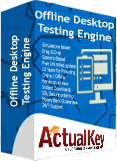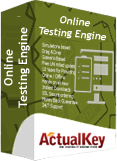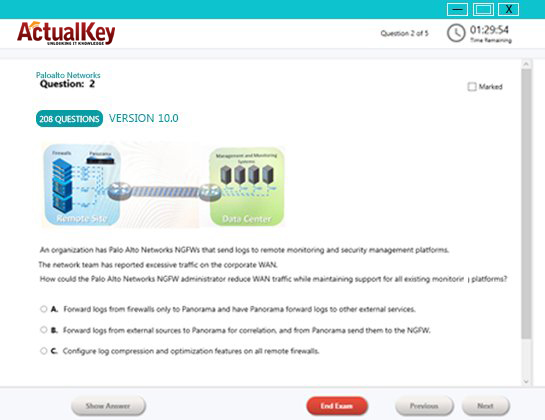Limited Time 30% Discount Offer Use Code - off30
Actualkey Prepration Latest CCST-Networking : Cisco Certified Support Technician (CCST) Networking Exam Questions and Answers PDF's, Verified Answers via Experts - Pass Your Exam For Sure and instant Downloads - "Money Back Guarantee".
| Vendor | Cisco |
| Certification | Cisco Certified Support Technicians |
| Exam Code | CCST-Networking |
| Title | Cisco Certified Support Technician (CCST) Networking Exam |
| No Of Questions | 40 |
| Last Updated | November 7,2024 |
| Product Type | Q & A with Explanation |
| Bundel Pack Included | PDF + Offline / Andriod Testing Engine and Simulator |
Cisco Certified Support Technician (CCST) Networking Exam
Exam Description
To earn your CCST Networking certification, you must pass the exam. This 50-minute exam tests your knowledge of:
Cisco Certified Support Technician
Networking
The successful candidate has the foundational knowledge and skills necessary to demonstrate how networks operate, including the devices, media, and protocols that enable network communication. This
test will be an entry point into the Cisco certification program. The next certification in the pathway is CCNA.
This is a certification for entry-level network technicians, networking students, interns, etc. The exam targets secondary and immediate post-secondary students, and entry-level IT and Networking
professionals. The successful candidates are qualified entry-level network technicians and customer support technicians, students, and interns with at least 150 hours of instruction and hands-on experience.
Objectives
1. Standards and Concepts
1.1. Identify the fundamental conceptual building blocks of networks.
• TCP/IP model, OSI model, frames and packets, addressing
1.2. Differentiate between bandwidth and throughput.
• Latency, delay, speed test vs. Iperf
1.3. Differentiate between LAN, WAN, MAN, CAN, PAN, and WLAN.
• Identify and illustrate common physical and logical network topologies.
1.4. Compare and contrast cloud and on-premises applications and services.
• Public, private, hybrid, SaaS, PaaS, IaaS, remote work/hybrid work
1.5. Describe common network applications and protocols.
• TCP vs. UDP (connection-oriented vs. connectionless), FTP, SFTP, TFTP, HTTP, HTTPS,
DHCP, DNS, ICMP, NTP
2. Addressing and Subnet Formats
2.1. Compare and contrast private addresses and public addresses.
• Address classes, NAT concepts
2.2. Identify IPv4 addresses and subnet formats.
• Subnet concepts, Subnet Calculator, slash notation, and subnet mask; broadcast domain
2.3. Identify IPv6 addresses and prefix formats.
• Types of addresses, prefix concepts
3. Endpoints and Media Types
3.1. Identify cables and connectors commonly used in local area networks.
• Cable types: fiber, copper, twisted pair; Connector types: coax, RJ-45, RJ-11, fiber connector types
3.2. Differentiate between Wi-Fi, cellular, and wired network technologies.
• Copper, including sources of interference; fiber; wireless, including 802.11 (unlicensed,
2.4GHz, 5GHz, 6GHz), cellular (licensed), sources of interference
3.3. Describe endpoint devices.
• Internet of Things (IoT) devices, computers, mobile devices, IP Phone, printer, server
3.4. Demonstrate how to set up and check network connectivity on Windows, Linux, Mac OS, Android, and Apple iOS.
• Networking utilities on Windows, Linux, Android, and Apple operating systems; how to run troubleshooting commands; wireless client settings (SSID, authentication, WPA mode)
4. Infrastructure
4.1. Identify the status lights on a Cisco device when given instruction by an engineer.
• Link light color and status (blinking or solid)
4.2. Use a network diagram provided by an engineer to attach the appropriate cables.
• Patch cables, switches and routers, small topologies, power, rack layout
4.3. Identify the various ports on network devices.
• Console port, serial port, fiber port, Ethernet ports, SFPs, USB port, PoE
4.4. Explain basic routing concepts.
• Default gateway, layer 2 vs. layer 3 switches, local network vs. remote network
4.5. Explain basic switching concepts.
• MAC address tables, MAC address filtering, VLAN
5. Diagnosing Problems
5.1. Demonstrate effective troubleshooting methodologies and help desk best practices, including ticketing, documentation, and information gathering.
• Policies and procedures, accurate and complete documentation, prioritization
5.2. Perform a packet capture with Wireshark and save it to a file.
• Purpose of using a packet analyzer, saving and opening a .pcap file
5.3. Run basic diagnostic commands and interpret the results.
• ping, ipconfig/ifconfig/ip, tracert/traceroute, nslookup; recognize how firewalls can influence the result
5.4. Differentiate between different ways to access and collect data about network devices.
• Remote access (RDP, SSH, telnet), VPN, terminal emulators, Console, Network Management Systems, cloud-managed network (Meraki), scripts
5.5. Run basic show commands on a Cisco network device.
• show run, show cdp neighbors, show ip interface brief, show ip route, show version, show inventory, show switch, show mac address-table, show interface, show interface x, show interface status; privilege levels; command help and auto-complete
6. Security
6.1. Describe how firewalls operate to filter traffic.
• Firewalls (blocked ports and protocols); rules deny or permit access
6.2. Describe foundational security concepts.
• Confidentiality, integrity, and availability (CIA); authentication, authorization, and accounting (AAA); Multifactor Authentication (MFA); encryption, certificates, and password complexity; identity stores/databases (Active Directory); threats and
vulnerabilities; spam, phishing, malware, and denial of service
6.3. Configure basic wireless security on a home router (WPAx).
• WPA, WPA2, WPA3; choosing between Personal and Enterprise; wireless security concepts
Sample Question and Answes
QUESTION 1
What is the most compressed valid format of the IPv6 address 2001 :0db8:0000:0016:0000:001b:2000:0056?
A. 2001:db8: : 16: : 1b:2:56
B. 2001:db8: : 16: : 1b: 2000: 56
C. 2001:db8: 16: :1b:2:56
D. 2001:db8: 0:16: :1b: 2000:56
Answer: D
Explanation:
IPv6 addresses can be compressed by removing leading zeros and replacing consecutive groups of
zeros with a double colon (::). Heres how to compress the address
2001:0db8:0000:0016:0000:001b:2000:0056:
Remove leading zeros from each segment:
2001:db8:0000:0016:0000:001b:2000:0056 becomes 2001:db8:0:16:0:1b:2000:56
Replace the longest sequence of consecutive zeros with a double colon (::). In this case, the two
consecutive zeros between the 16 and 1b:
2001:db8:0:16::1b:2000:56
Thus, the most compressed valid format of the IPv6 address is 2001:db8:0:16::1b:2000:56.
Reference :=
Cisco Learning Network
IPv6 Addressing (Cisco)
QUESTION 2
HOTSPOT
For each statement about bandwidth and throughput, select True or False.
Note: You will receive partial credit for each correct selection.
Answer:
Explanation:
Statement 1: Low bandwidth can increase network latency.
True: Low bandwidth can result in increased network latency because the network may become
congested, leading to delays in data transmission.
Statement 2: High levels of network latency decrease network bandwidth.
False: High levels of network latency do not decrease the available network bandwidth, but they do
affect the perceived performance and throughput of the network.
Statement 3: You can increase throughput by decreasing network latency.
True: Decreasing network latency can increase throughput because data can be transmitted more
quickly and efficiently without delays.
Bandwidth vs. Latency: Bandwidth refers to the maximum rate at which data can be transferred over
a network path. Latency is the time it takes for a data packet to travel from the source to the
destination.
Low bandwidth can cause network congestion, which can increase latency as packets wait to be transmitted.
High latency does not reduce the actual bandwidth but can affect the overall performance and efficiency of data transmission.
Reducing latency can lead to higher throughput because the network can handle more data in a given period without delays.
Reference:
Network Performance Metrics: Cisco Network Performance
Understanding Bandwidth and Latency: Bandwidth vs. Latency
QUESTION 3
DRAG DROP
Move each protocol from the list on the left to its correct example on the right.
Answer:
Explanation:
The correct matching of the protocols to their examples is as follows:
DHCP: Assign the reserved IP address 10.10.10.200 to a web server at your company.
DNS: Perform a query to translate companypro.net to an IP address.
ICMP: Perform a ping to ensure that a server is responding to network connections.
Heres how each protocol corresponds to its example:
DHCP (Dynamic Host Configuration Protocol) is used to assign IP addresses to devices on a network.
In this case, DHCP would be used to assign the reserved IP address 10.10.10.200 to a web server.
DNS (Domain Name System) is used to translate domain names into IP addresses. Therefore, to
translate companypro.net to an IP address, DNS would be utilized.
ICMP (Internet Control Message Protocol) is used for sending error messages and operational
information indicating success or failure when communicating with another IP address. An example
of this is using the ping command to check if a server is responding to network connections.
These protocols are essential for the smooth operation of networks and the internet.
Perform a query to translate companypro.net to an IP address.
DNS (Domain Name System): DNS is used to resolve domain names to IP addresses.
Assign the reserved IP address 10.10.10.200 to a web server at your company.
DHCP (Dynamic Host Configuration Protocol): DHCP is used to assign IP addresses to devices on a
network.
Perform a ping to ensure that a server is responding to network connections.
ICMP (Internet Control Message Protocol): ICMP is used by network devices to send error messages
and operational information, and it is the protocol used by the ping command.
DNS (Domain Name System): DNS translates human-friendly domain names like "companypro.net"
into IP addresses that computers use to identify each other on the network.
DHCP (Dynamic Host Configuration Protocol): DHCP automatically assigns IP addresses to devices on
a network, ensuring that no two devices have the same IP address.
ICMP (Internet Control Message Protocol): ICMP is used for diagnostic or control purposes, and the
ping command uses ICMP to test the reachability of a host on an IP network.
Reference:
DNS Basics: What is DNS?
DHCP Overview: What is DHCP?
ICMP and Ping: Understanding ICMP
QUESTION 4
Which protocol allows you to securely upload files to another computer on the internet?
A. SFTP
B. ICMP
C. NTP
D. HTTP
Answer: A
Explanation:
SFTP, or Secure File Transfer Protocol, is a protocol that allows for secure file transfer capabilities
between networked hosts. It is a secure extension of the File Transfer Protocol (FTP). SFTP encrypts
both commands and data, preventing passwords and sensitive information from being transmitted
openly over the network. It is typically used for secure file transfers over the internet and is built on
the Secure Shell (SSH) protocol1.
Reference :=
What Is SFTP? (Secure File Transfer Protocol)
How to Use SFTP to Safely Transfer Files: A Step-by-Step Guide
Secure File Transfers: Best Practices, Protocols And Tools
The Secure File Transfer Protocol (SFTP) is a secure version of the File Transfer Protocol (FTP) that
uses SSH (Secure Shell) to encrypt all commands and data. This ensures that sensitive information,
such as usernames, passwords, and files being transferred, are securely transmitted over the
network.
ICMP (Internet Control Message Protocol) is used for network diagnostics and is not
designed for file transfer.
NTP (Network Time Protocol) is used to synchronize clocks between computer systems and is
not related to file transfer.
HTTP (HyperText Transfer Protocol) is used for transmitting web pages over the internet and
does not inherently provide secure file transfer capabilities.
Thus, the correct protocol that allows secure uploading of files to another computer on the internet
is SFTP.
Reference :=
Cisco Learning Network
SFTP Overview (Cisco)
QUESTION 5
A local company requires two networks in two new buildings. The addresses used in these networks
must be in the private network range.
Which two address ranges should the company use? (Choose 2.)
Note: You will receive partial credit for each correct selection.
A. 172.16.0.0 to 172.31.255.255
B. 192.16.0.0 to 192.16.255.255
C. 11.0.0.0 to 11.255.255.255
D. 192.168.0.0 to 192.168.255.255
Answer: AD
Explanation:
The private IP address ranges that are set aside specifically for use within private networks and not
routable on the internet are as follows:
Class A: 10.0.0.0 to 10.255.255.255
Class B: 172.16.0.0 to 172.31.255.255
Class C: 192.168.0.0 to 192.168.255.255
These ranges are defined by the Internet Assigned Numbers Authority (IANA) and are used for local
communications within a private network123.
Given the options:
A. 172.16.0.0 to 172.31.255.255 falls within the Class B private range. B.
192.16.0.0 to 192.16.255.255 is not a recognized private IP range. C. 11.0.0.0 to 11.255.255.255 is
not a recognized private IP range. D. 192.168.0.0 to 192.168.255.255 falls within the Class C private
range.
Therefore, the correct selections that the company should use for their private networks are A and D.
Reference :=
Reserved IP addresses on Wikipedia
Private IP Addresses in Networking - GeeksforGeeks
Understanding Private IP Ranges, Uses, Benefits, and Warnings
I Got My Success Due To Actualkey CCST-Networking Bundle Pack Actualkey experts I got passed in the CCST-Networking exam without any worries at all, these exam material products gave me the reason to relax.
Budi Saptarmat
Yahoo! Got Successfully Through The CCST-Networking Exam Passing Exam is not a easy thanks to Acutalkey.com for providing me actual CCST-Networking Cisco Certified Support Technician (CCST) Networking Exam training with there included the Offline and Android simulators helps me success
Melinda
CCST-Networking Exam Best Preparation I have been preparing for CCST-Networking Cisco Certified Support Technician (CCST) Networking Exam, I was not sure that I'll be able to pass because of the fact that I am not a good student however;Actualkey.com provided me best and simple exam training pdf's and I passed. I now recommend everyone
Antonio Moreno
Actualkey.com CCST-Networking Offline Simulator is Best My choice to select Actualkey.com and go for the preparation CCST-Networking Cisco Certified Support Technician (CCST) Networking Exam, because I got the short way with the easy way
Liliane Meichner
Actualkey.com CCST-Networking Exam PDF"s passed with in a week CCST-Networking exam pdf's that's amazing
James Wilson
Cisco - RELATED EXAMS
Implementing Cisco Unified Communications Manager Part 2 (CIPT2 v6.0)
Questions: 174 | May 8, 2024
Implementing Cisco Security Monitoring, Analysis andResponse System
Questions: 49 | May 8, 2024
Cisco Wide Area Application Services for System Engineers exam
Questions: 60 | August 1, 2024
Cisco Data Center Networking Infrastructure Solutions design
Questions: 120 | August 1, 2024
Implementing Cisco Unified Wireless Networking Essentials (IUWNE)
Questions: 203 | July 1, 2024
Associated Certifications: Cisco Storage Networking Support Specialist
Questions: 74 | August 1, 2024
Implementing Cisco Security Monitoring, Analysis, and Response System
Questions: 67 | August 1, 2024
Wide Area Application Services for System Engineers (WAASSE)
Questions: 90 | January 5, 2024
Implementing Advanced Cisco Unified Wireless Security (IAUWS)
Questions: 85 | January 7, 2024
Troubleshooting and Maintaining Cisco IP Switched Networks (TSHOOT)
Questions: 72 | January 7, 2024
Implementing Cisco Unified Communications Voice over IP and QoS v8.0 (CVOICE v8.0)
Questions: 257 | July 1, 2024
Securing Networks with Cisco Routers and Switches (SECURE) v1.0
Questions: 136 | July 1, 2024
Implementing Cisco Unified CommunicationsManager, Part 2 v8.0 (CIPT2 v8.0)
Questions: 215 | July 1, 2024
Introducing Cisco Voice and Unified Communications Administration v8.0
Questions: 300 | May 8, 2024
Integrating Cisco Unified Communications Applications v8.0 (CAPPS v8.0)
Questions: 203 | May 8, 2024
Operational Foundations for Cisco Service Provider Core Networks
Questions: 91 | May 8, 2024
Maintaining Cisco Service Provider VPNs and MPLS Networks (MSPVM)
Questions: 89 | May 8, 2024
Cisco Data Center Unified Computing Support Specialist Qualifier Exam (DCUCI Qualifier Exam)
Questions: 65 | May 8, 2024
Cisco Data Center Unified Computing Design Specialist Qualifier Exam
Questions: 62 | May 8, 2024
Designing for Cisco Internetwork Solutions Exam (DESGN) v2.1
Questions: 241 | October 1, 2024
Maintaining Cisco Service Provider Routing Protocols (MSPRP)
Questions: 70 | October 1, 2024
Maintaining Cisco Service Provider Quality of Service (MSPQS)
Questions: 91 | October 1, 2024
PSACAS Advanced Collaboration Architecture Sales Specialist Exam
Questions: 56 | May 8, 2024
PSACASE Advanced Collaboration Architecture System Engineer Exam
Questions: 64 | May 8, 2024
PSACAFE Advanced Collaboration Architecture Field Engineer Exam
Questions: 50 | August 1, 2024
Cisco IronPort Certified Security Professional (CICSP) Web Security 7.0
Questions: 66 | August 1, 2024
Implementing Cisco TelePresence Video Networking Solutions Exam
Questions: 57 | August 1, 2024
Advanced Borderless Network Architecture Systems Engineer Exam
Questions: 60 | August 1, 2024
Cisco Substation Automation System and Field Engineer Knowledge Verification
Questions: 58 | May 8, 2024
Authorized Connected Grid Account Manager Knowledge Verification
Questions: 23 | August 1, 2024
Cisco Data Center Unified Computing Systems Implementation (DCUCI)
Questions: 78 | May 8, 2024
Introduction to 802.1X Operations for Cisco Security Professionals Exam (S802DT1X)
Questions: 69 | May 8, 2024
Introducing Cisco Identity Services Engine for System Engineer Exam (PAISESE)
Questions: 34 | May 8, 2024
PASCERAM - Cisco SaaS Conferencing and EIM Resale ATP for the AM Exam
Questions: 35 | May 8, 2024
Cisco SP Video Wireline & Cable Headend Design Specialist for SE
Questions: 33 | May 8, 2024
PASCERSE - Cisco SaaS Conferencing and EIM Resale ATP for the SE Exam
Questions: 56 | May 8, 2024
Building Cisco Service Provider Next-Generation Networks, Part 2
Questions: 126 | May 8, 2024
Building Cisco Service Provider Next-Generation Networks, Part 1 Exam
Questions: 257 | October 25, 2024
Implementing Advanced Cisco Unified Wireless Security (IAUWS) v2.0
Questions: 206 | May 8, 2024
Deploying Cisco Service Provider Network Routing (SPROUTE)
Questions: 174 | January 12, 2024
Implementing Cisco Service Provider Next-Generation Core Network Services (SPCORE)
Questions: 184 | January 12, 2024
Implementing Cisco Service Provider Next-Generation Edge Network Services (SPEDGE) Exam
Questions: 185 | January 12, 2024
Implementing and Maintaining Cisco Technologies Using IOS XR - (IMTXR)
Questions: 77 | January 12, 2024
Designing and Implementing Cisco Unified Communications on Unified Computing Systems - DIUCUCS
Questions: 60 | January 12, 2024
Implementing and Configuring Cisco Identity Service Engine - SISE
Questions: 49 | July 1, 2024
PASCERFE - Cisco SaaS Conferencing and EIM Resale ATP for the FE Exam
Questions: 53 | July 1, 2024
Advanced Borderless Network Architecture Field Engineer Exam
Questions: 86 | January 15, 2024
Advanced Borderless Network Architecture Systems Engineer Exam (700-303)
Questions: 156 | January 15, 2024
Cisco Implementing Cisco Secure Mobility Solutions Exam (SIMOS)
Questions: 543 | May 17, 2024
Unified Communications Contact Center Express Implementation - UCCX
Questions: 50 | January 15, 2024
Performing Business-Focused Transformative Architecture Engagements
Questions: 67 | January 17, 2024
Configuring Cisco UCS and Cisco Catalyst 3000 for Vblock Series 100
Questions: 45 | January 17, 2024
Cisco Application Centric Infrastructure for System Engineers
Questions: 58 | January 17, 2024
Implementing Cisco Service Provider Mobile Unlicensed Small Cell Solutions
Questions: 51 | January 17, 2024
Securing Cisco Networks with Sourcefire Intrusion Prevention System
Questions: 59 | January 17, 2024
Implementing Cisco Service Provider Mobility UMTS Networks (SPUMTS)
Questions: 70 | January 17, 2024
Implementing Cisco Service Provider Mobility CDMA Networks (SPCDMA)
Questions: 70 | January 17, 2024
Implementing Cisco Service Provider Mobility LTE Networks (SPLTE)
Questions: 70 | January 17, 2024
Integrating Business Applications with Network Programmability (NPIBA)
Questions: 66 | January 17, 2024
Managing Industrial Networks with Cisco Networking Technologies (IMINS)
Questions: 64 | January 17, 2024
Designing with Cisco Network Programmability for ACI (NPDESACI)
Questions: 60 | January 17, 2024
Implementing with Cisco Network Programmability for ACI (NPENGACI)
Questions: 60 | January 17, 2024
Cisco Application Centric Infrastructure for Account Managers
Questions: 41 | January 17, 2024
Executing Cisco Advanced Business Value Analysis and Design Techniques
Questions: 60 | July 1, 2024
Troubleshooting and Maintaining Cisco IP Networks (TSHOOT)
Questions: 254/24Case Study | January 18, 2024
Cisco Application Centric Infrastructure for Field Engineers Exam
Questions: 50 | September 16, 2024
Implementing and Supporting Cisco Unified Contact Center Enterprise Exam
Questions: 95 | September 16, 2024
Executing Cisco Advanced Business Value Analysis and Design Techniques
Questions: 182 | September 16, 2024
Applying Cisco Specialized Business Value Analysis Skills
Questions: 173 | September 16, 2024
Cisco Implementing Cisco Wireless Network Fundamentals Exam
Questions: 509 | September 16, 2024
Managing Industrial Networks for Manufacturing with Cisco Technologies
Questions: 87 | September 16, 2024
Cisco Implementing and Troubleshooting the Cisco Cloud Infrastructure Exam
Questions: 132 | September 16, 2024
Building the Cisco Cloud with Application Centric Infrastructure
Questions: 60 | September 16, 2024
Cisco Leading Virtual Classroom Instruction - Written Exam
Questions: coming soon | September 16, 2024
Cisco Leading Virtual Classroom Instruction - Practical Exam
Questions: coming soon | September 16, 2024
Integrating Business Applications with Network Programmability
Questions: coming soon | January 19, 2024
Cisco Implementing Cisco Data Center Virtualization and Automation Exam
Questions: 167 | January 21, 2024
Cisco Midsize Collaboration Solutions for Account Managers (MCAM)
Questions: 30 | April 11, 2024
Cisco Data Center Unified Computing Infrastructure Design (DCICUC)
Questions: 40 | January 21, 2024
Cisco Enterprise Networks SDA, SDWAN and ISE Exam for System Engineers
Questions: 35 | January 21, 2024
Automating and Programming Cisco Security Solutions (SAUTO) Exam
Questions: 332 | May 9, 2024
Implementing and Operating Cisco Enterprise Network Core Technologies (ENCOR) Exam
Questions: 1172 | March 14, 2025
Implementing and Operating Cisco Data Center Core Technologies (DCCOR) Exam
Questions: 633 | May 10, 2024
Implementing Cisco Enterprise Advanced Routing and Services (ENARSI) Exam
Questions: 598 | March 14, 2025
Understanding Cisco Cybersecurity Operations Fundamentals (CBROPS) Exam
Questions: 430 | May 9, 2024
Designing Cisco Enterprise Wireless Networks (300-425 ENWLSD) Exam
Questions: 196 | November 8, 2024
Implementing Cisco Enterprise Wireless Networks (300-430 ENWLSI) Exam
Questions: 216 | November 8, 2024
Automating and Programming Cisco Enterprise Solutions (ENAUTO 300-435) Exam
Questions: 125 | November 8, 2024
Designing Cisco Data Center Infrastructure (300-610 DCID) Exam
Questions: 204 | November 8, 2024
Troubleshooting Cisco Data Center Infrastructure (300-615 DCIT) Exam
Questions: 517 | November 8, 2024
Implementing Cisco Application Centric Infrastructure (300-620 DCACI) Exam
Questions: 192 | November 8, 2024
Implementing Cisco Storage Area Networking (300-625 DCSAN) Exam
Questions: 60 | November 8, 2024
Securing Networks with Cisco Firepower (300-710 SNCF) Exam
Questions: 325 | November 8, 2024
Implementing and Configuring Cisco Identity Services Engine (300-715 SISE) Exam
Questions: 244 | November 8, 2024
Securing Email with Cisco Email Security Appliance (300-720 SESA) Exam
Questions: 147 | November 8, 2024
Securing the Web with Cisco Web Security Appliance (300-725 SWSA) Exam
Questions: 60 | November 8, 2024
Implementing Secure Solutions with Virtual Private Networks (SVPN 300-730) Exam
Questions: 175 | November 8, 2024
Implementing Cisco Collaboration Applications (300-810 CLICA) Exam
Questions: 213 | November 8, 2024
Implementing Cisco Advanced Call Control and Mobility Services (300-815 CLACCM) Exam
Questions: 174 | November 8, 2024
Implementing Cisco Collaboration Cloud and Edge Solutions (300-820 CLCEI)
Questions: 93 | November 8, 2024
Implementing DevOps Solutions and Practices using Cisco Platforms (300-910 DEVOPS) Exam
Questions: 130 | November 8, 2024
Developing Applications for Cisco Webex and Webex Devices (300-920 DEVWBX) Exam
Questions: 60 | November 8, 2024
Implementing and Operating Cisco Service Provider Network Core Technologies (350-501 SPCOR)
Questions: 452 | November 8, 2024
Implementing and Operating Cisco Security Core Technologies (SCOR 350-701) Exam
Questions: 633 | November 8, 2024
Implementing Cisco Collaboration Core Technologies (350-801 CLCOR) Exam
Questions: 273 | November 8, 2024
Developing Applications using Cisco Core Platforms and APIs v1.0 (DEVCOR 350-901) Exam
Questions: 363 | November 8, 2024
Designing Cisco Unified Contact Center Enterprise (UCCED) Exam
Questions: 93 | November 8, 2024
Implementing Cisco Application Centric Infrastructure - Advanced (600-660 - 300-630 DCACIA)
Questions: 76 | November 8, 2024
Supporting Cisco Routing and Switching Network Devices v3.0 - RSTECH Exam
Questions: 72 | November 8, 2024
Cisco Security Architecture for System Engineers (ASASE) Exam
Questions: 92 | November 8, 2024
Implementing Cisco Service Provider Advanced Routing Solutions (SPRI) Exam
Questions: 214 | November 8, 2024
Implementing Cisco Service Provider VPN Services (300-515 SPVI) Exam
Questions: 71 | November 8, 2024
Developing Solutions Using Cisco IoT and Edge Platforms (DEVIOT) Exam
Questions: 60 | November 8, 2024
Conducting Forensic Analysis and Incident Response Using Cisco CyberOps Technologies (CBRFIR) Exam
Questions: 59 | May 10, 2024
Performing CyberOps Using Core Security Technologies (CBRCOR) Exam
Questions: 139 | May 10, 2024
Implementing Cisco Collaboration Conferencing (CLCNF) Exam
Questions: 60 | September 16, 2024
Implementing Cisco SD-WAN Solutions (ENSDWI) Exam Corresponding Certification: CCNP Enterprise
Questions: 163 | September 16, 2024
Cisco Data Center Unified Computing Infrastructure Troubleshooting Exam
Questions: 40 | September 16, 2024
ENCOR Implementing and Operating Cisco Enterprise Network Core Technologies
Questions: 747 | May 10, 2024
Cisco Advanced Administration and Reporting of Contact Center Enterprise Exam
Questions: 60 | July 1, 2024
Cisco Certified Support Technician (CCST) Networking Exam
Questions: 40 | November 7, 2024
Cisco Collaboration SaaS Authorization for PreSales Engineer Exam
Questions: 60 | September 4, 2024
Exams code, certifications, vendor or keywords
![]()
Copyright © 2009 - 2025 Actualkey. All rights reserved.





